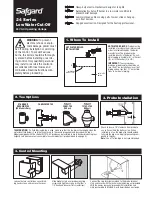
www.petsafe.net
www.petsafe.net
3
DE
IT
NL
ES
FR
EN
This PetSafe
®
In-Ground Fence
™
System is not a solid barrier. This system is designed to act as a deterrent
to remind pets by Static Stimulation to remain in the boundary established. It is important that you reinforce
training with your pet on a regular basis. Proper fit of the collar is important. A collar worn for too long or
made too tight on the pet’s neck may cause skin damage. Ranging from redness to pressure ulcers; this
condition is commonly known as bed sores.
• Avoid leaving the collar on the dog for more than 12 hours per day.
• When possible reposition the collar on the pet’s neck every 1 to 2 hours.
• Check the fit to prevent excessive pressure; follow the instructions in this manual.
• Never connect a lead to the electronic collar; it will cause excessive pressure on the contacts.
• When using a separate collar for a lead, don’t put pressure on the electronic collar.
• Wash the dog’s neck area and the contacts of the collar weekly with a damp cloth.
• Examine the contact area daily for signs of a rash or a sore.
• If a rash or sore is found, discontinue use of the collar until the skin has healed.
• If the condition persists beyond 48 hours, see your veterinarian.
For additional information on bed sores and pressure necrosis, please visit our website.
These steps will help keep your pet secure and comfortable. Millions of pets are comfortable while they
wear stainless steel contacts. Some pets are sensitive to contact pressure. You may find after some time
that your pet is very tolerant of the collar. If so, you may relax some of these precautions. It is important to
continue daily checks of the contact area. If redness or sores are found, discontinue use until the skin has
fully healed.
• You may need to trim the hair in the area of the Contact Points. Never shave the dog’s neck; this may
lead to a rash or infection.
• You should not make the collar any tighter than is required for good contact. A collar that is too tight
will increase the risk of pressure necrosis in the contact area.
• Proper training of your pet is essential to the success of the PetSafe
®
In-Ground Fence
™
System. During
the first 2 weeks of training, do not use the training device on your pet without direct supervision.
• The Receiver Collar should not be on your dog when the system is tested. Your pet may receive an
unintended stimulation.
• The Boundary Width of the system must be tested whenever an adjustment is made to the containment
field to prevent unintended stimulations to your pet.
• Always remove your dog’s Receiver Collar before performing any Transmitter testing.
• If possible, do not use an outlet protected with a residual current device (RCD) or ground fault circuit
interrupter (GFCI). The fence system will function properly, but in rare cases, nearby lightning strikes
may cause the RCD or GFCI to trip. Without power, your pet may be vulnerable to escape. You will
have to reset the RCD or GFCI to restore power to the system.
• Avoid damage to the insulation of the loop wire during the install; damage may cause areas of weak
signal and lead to early failure of the loop (wire breaks).
• Use care when mowing or trimming your grass not to cut the loop wire.
• For added protection for the Fence Transmitter when unused for long periods of time or prior to
thunderstorms, disconnect the Loop Boundary Wires and unplug the Power Adaptor from the outlet. This
will prevent damage to the Transmitter due to surges.
• To prevent an unintended stimulation, after the Boundary Flags have been placed, be sure to set the
static stimulation on the receiver collar back to level 1 tone only.
• Before you begin installing the Boundary Wire, unplug the Fence Transmitter power adaptor from
the outlet.




































